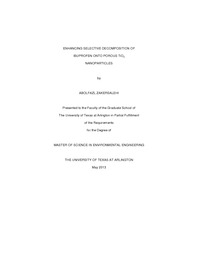
ATTENTION: The works hosted here are being migrated to a new repository that will consolidate resources, improve discoverability, and better show UTA's research impact on the global community. We will update authors as the migration progresses. Please see MavMatrix for more information.
Show simple item record
| dc.contributor.author | Zakersalehi, Abolfazl | en_US |
| dc.date.accessioned | 2014-03-10T21:17:09Z | |
| dc.date.available | 2014-03-10T21:17:09Z | |
| dc.date.issued | 2014-03-10 | |
| dc.date.submitted | January 2013 | en_US |
| dc.identifier.other | DISS-12134 | en_US |
| dc.identifier.uri | http://hdl.handle.net/10106/24035 | |
| dc.description.abstract | Advanced oxidation technologies have gained tremendous attention for water treatment purposes after demonstration of insufficient efficiency of conventional systems for removal of many emerging chemicals of concern. Among AOTs, a TiO₂-UV system is one of the most promising approaches due to its green properties and its effectiveness in generation of extremely oxidizing species such as hydroxyl radicals. However it has been demonstrated that non-selectivity of HRs in decomposition of organic compounds results in parallel decomposing of naturally abundant organic matter (NOM) along with toxic target contaminant, which significantly decreases the decomposition rate of target contaminants. Despite a great amount of researches conducted on TiO₂ photocatalysts, limited success has been achieved in enhancing selectivity of TiO₂ photocatalytic oxidation. In this study. a novel approach for suppressing the adverse effect of co-existing organics such as NOM has been proposed. Physical access of competing compounds was restrained through manipulation of the porous structure of TiO₂ photocatalysts. An advanced templating method was employed to create a porous structure across TiO₂ nanoparticles. In this study Ibuprofen as a target contaminant was decomposed in the presence of humic acid as competing NOM. Porous particles demonstrated significant improvement in selective decomposition of ibuprofen in the presence of humic acid as competing species. In the second phase of the study, a comprehensive study was conducted through changing the porous structure and size of co-existing organics in competing and non-competing conditions. The photocatalytic results, in correlation with material characterization demonstrated beneficial role of the controlled porous structure on adsorption followed by decomposition of organic species onto TiO₂ photocatalysts. | en_US |
| dc.description.sponsorship | Choi, Hyeok | en_US |
| dc.language.iso | en | en_US |
| dc.publisher | Civil & Environmental Engineering | en_US |
| dc.title | Enhancing Selective Decomposition Of Ibuprofen Onto Porous TiO₂ Nanoparticles | en_US |
| dc.type | M.S. | en_US |
| dc.contributor.committeeChair | Choi, Hyeok | en_US |
| dc.degree.department | Civil & Environmental Engineering | en_US |
| dc.degree.discipline | Civil & Environmental Engineering | en_US |
| dc.degree.grantor | University of Texas at Arlington | en_US |
| dc.degree.level | masters | en_US |
| dc.degree.name | M.S. | en_US |
Files in this item
- Name:
- Zakersalehi_uta_2502M_12134.pdf
- Size:
- 1.778Mb
- Format:
- PDF
This item appears in the following Collection(s)
Show simple item record


